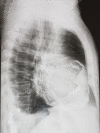Cardiovascular involvement in COVID-19: not to be missed
- PMID: 32864934
- PMCID: PMC7454637
- DOI: 10.21470/1678-9741-2020-0224
Cardiovascular involvement in COVID-19: not to be missed
Abstract
In December 2019, a striking appearance of new cases of viral pneumonia in Wuhan led to the detection of a novel coronavirus (SARS-CoV2). By analyzing patients with severe manifestations, it became apparent that 20 to 35% of patients who died had preexisting cardiovascular disease. This finding warrants the important need to discuss the influence of SARS-CoV2 infection on the cardiovascular system and hemodynamics in the context of clinical management, particularly during mechanical ventilation. The SARS-CoV2 enters human cells through the spike protein binding to angiotensin-converting enzyme 2 (ACE2), which is important to cardiovascular modulation and endothelial signaling. As ACE2 is highly expressed in lung tissue, patients have been progressing to acute respiratory injury at an alarming frequency during the Coronavirus Disease (COVID-19) pandemic. Moreover, COVID-19 leads to high D-dimer levels and prothrombin time, which indicates a substantial coagulation disorder. It seems that an overwhelming inflammatory and thrombogenic condition is responsible for a mismatching of ventilation and perfusion, with a somewhat near-normal static lung compliance, which describes two types of pulmonary conditions. As such, positive pressure during invasive mechanical ventilation (IMV) must be applied with caution. The authors of this review appeal to the necessity of paying closer attention to assess microhemodynamic repercussion, by monitoring central venous oxygen saturation during strategies of IMV. It is well known that a severe respiratory infection and a scattered inflammatory process can cause non-ischemic myocardial injury, including progression to myocarditis. Early strategies that guide clinical decisions can be lifesaving and prevent extended myocardial damage. Moreover, cardiopulmonary failure refractory to standard treatment may necessitate the use of extreme therapeutic strategies, such as extracorporeal membrane oxygenation.
Keywords: Angiotensin Converting Enzyme 2; COVID-19; Cardiovascular Diseases; Extracorporeal Membrane Oxygenation; Mechanical Ventilation; Myocarditis; Pneumonia, Viral; SARS-CoV2.
Conflict of interest statement
No conflict of interest.
Figures

References
-
- World Health Organization - WHO . Coronavirus disease (COVID-19) Pandemic [Internet] Genova: WHO; 2020. [2020 May 06]. Available from: https://www.who.int/emergencies/diseases/novel-coronavirus-2019.
Publication types
MeSH terms
LinkOut - more resources
Full Text Sources
Research Materials
Miscellaneous
